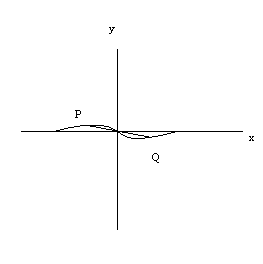1.2: Graphs and Symmetry
( \newcommand{\kernel}{\mathrm{null}\,}\)
Symmetry (Geometry)
Definition: Symmetric with respect to the y-axis
We say that a graph is symmetric with respect to the y-axis if for every point (a,b) on the graph, there is also a point (−a,b) on the graph; hence f(x,y)=f(−x,y).
Visually we have that the y-axis acts as a mirror for the graph. We will demonstrate several functions to test for symmetry graphically using the graphing calculator.

Definition: Symmetric with respect to the x-axis
We say that a graph is symmetric with respect to the x axis if for every point (a,b) on the graph, there is also a point (a,−b) on the graph; hence f(x,y)=f(x,−y).
Visually we have that the x-axis acts as a mirror for the graph. We will demonstrate several functions to test for symmetry graphically using the graphing calculator.
Definition: Symmetry with respect to Origin
We say that a graph is symmetric with respect to the origin if for every point (a,b) on the graph, there is also a point (−a,−b) on the graph; hence f(x,y)=f(−x,−y).
Visually we have that given a point P on the graph if we draw a line segment PQ through P and the origin such that the origin is the midpoint of PQ, then Q is also on the graph.

We will use the graphing calculator to test for all three symmetries.
Symmetry (Algebra)
x-axis Symmetry
To test algebraically if a graph is symmetric with respect the x-axis, we replace all the y's with −y and see if we get an equivalent expression.
Example 1.2.1
For
x−2y=5
we replace with
x−2(−y)=5.
Simplifying we get
x+2y=5.
Which is not equivalent to the original expression. So
x−2y=5
Is not symmetric with respect to the x-axis.
Example 1.2.2
For
x3−y2=2
we replace with
x3−(−y)2=2
which is equivalent to the original expression, so that
x3−y2=2
is symmetric with respect to the x-axis.
y-axis Symmetry
To test algebraically if a graph is symmetric with respect to the y axis, we replace all the x's with -x and see if we get an equivalent expression.
Example 1.2.3
For
y=x2
we replace with
y=(−x)2=x2
so that
y=x2
is symmetric with respect to the y-axis.
Example 1.2.4
For
y=x3
we replace with
y=(−x)3=−x3
so that
y=x3
is not symmetric with respect to the y-axis.
Origin Symmetry
To test algebraically if a graph is symmetric with respect to the origin we replace both x and y with −x and −y and see if the result is equivalent to the original expression.
Example 1.2.5
For
y=x3
we replace with
(−y)=(−x)3
so that
−y=−x3 or y=x3.
Hence
y=x3
is symmetric with respect to the origin.
Intercepts
We define the x intercepts as the points on the graph where the graph crosses the x axis. If a point is on the x axis, then the y coordinate of the point is 0. Hence to find the x intercepts, we set y=0 and solve.
Example 1.2.6: x intercepts
Find the x intercepts of
y=x2+x−2
Solution
We set y=0 so that
0=x2+x−2=(x+2)(x−1)
Hence that x intercepts are at (−2,0) and (1,0)
We define the y intercepts of a graph to be the points where the graph crosses the y-axis. At these points the x coordinate is 0 hence to find the y intercepts we set x=0 and find y.
Example 1.2.7: y intercepts
Find the y intercepts of
y=x2+x−2
Solution
We set x=0 to get:
y=0+0−2=−2.
Hence the y intercept is at (0,−2).
Contributors and Attributions
- Larry Green (Lake Tahoe Community College)
Integrated by Justin Marshall.


